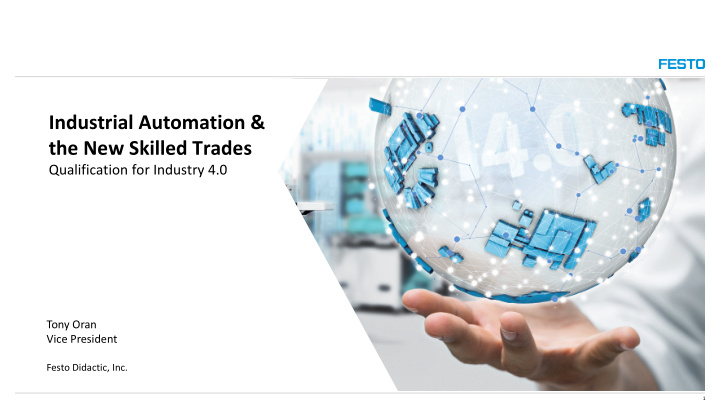



Industrial Automation & the New Skilled Trades Qualification for Industry 4.0 Tony Oran Vice President Festo Didactic, Inc. 1
Festo at a glance Services in 176 countries Turnover: Employees 3.5 Billion worldwide: 61 20,100 Companies Customers Education Over 250 Automation Investments: branch offices > 1,000,000 1.5% of Sales Customers Didactic > 56,000 2
Our business sectors From Industry — For Industry Partner of technical training and development. Technical Education Festo Festo Didactic Training and Automation Consulting Process Learning Automation Factory systems Automation 3
Complete Range of Learning Systems Across a Wide Range of Industries Factory automation Process automation Fluid power Electricity and electronics Electric power technology HVAC/Refrigeration Building system technology Industrial trades Environmental and renewable energy Telecommunications and radar technology 4
Why is now the time for training? Prime Influencers Deglobalization – Manufacturing is critical to our economy. In order to be competitive vs. low labor cost countries, US manufacturers must automate more and more processes. To achieve this, upskilling of existing workforce is needed. Industry 4.0 – The Fourth Industrial Revolution is here and bringing with it new technologies which requires continuous training Covid-19 – The way humans work together could be forever changed. Work from home, ability to work in close proximity, and now the need to be prepared for Covid-XX. Further, deglobalization will accelerate as a result of the pandemic. The implementation of collaborative robots will increase to further distance employees. Availability of skilled workforce – There is a gap between existing education output capacity and industry needs/demand. This coupled with the above factors will only widen the supply vs. demand gap. 5
Industry 4.0 Impacts 3.0 4.0 Third industrial revolution Fourth industrial revolution The use of computers and robots leads Industry 4.0 describes the networking of people, to greater production automation. machines, and products – in real time via the Internet. Central control Decentralized self-organization through ad-hoc networking Established value chains Virtual ad-hoc organizations Production system operation is planned in advance Autonomous, self-organizing production units Products are passive objects in the processing operation Active production process supported by intelligent products Source: Forschungsunion Wirtschaft – Wissenschaft 6
Industry 4.0 Advanced Manufacturing Evolution Source: Overview of Smart Manufacturing 2018 - Dr. Thorsten Wuest 7
Core elements of Industry 4.0 “...who am I ...” “...what can do I ...” “...what am doing I ...” Augmented Reality Big Data Condition Monitoring Communication standard • Extended reality / computer-assisted Unspecific search for correlations and Permanent or periodical measurements of Standard in the communication of machines expansion of reality perception patterns in available but unstructured data. physical variables. CM is considered as a (M2M) Securely exchanging structured data. • Currently mainly realized by smart glasses The goal is to detect unexpected connections building block of Smart Maintenance. Basis for optimization Machine-to-Machine RFID ERP/MES Cyber-physical-systems Communication Radio Frequency Identification (RFID) is a ERP takes over the task of planning, Merging of physical and virtual systems. They technology for the identification of products controlling and coordinating all resources in have their own intelligence in the form of M2M communication denotes the automated as well as a medium to store data. It is a company. MES performs the detailed microcontrollers and software, which allows data exchange between machines. Machines possible to read and write data from/on the planning of production processes and them to connect to the outside world via must be networked and ready for data RFID tag. resources. sensors and actuator. exchange. 8
Disruptions and Rapid Change Fuels the need for life long – customized learning Source: Forbes – May 12, 2020 https://www.forbes.com/sites/annashedletsky/2020/05/ 12/due-to-covid-19-manufacturing-will-experience-five- years-of-innovation-in-the-next-18- months/#6e38e4fa2312 “Automation has an unprecedented opportunity” 9
Implementation Planning and Resources 10
1 2 Outcomes of the The Festo Blended Learning Approach Employers – program: work analysis: After the Needed professions qualification Curriculum development: Work requirements program the 3 Duties and tasks students… • Can… • Are able to… Based on 4 Certification DACUM Competence development 10 methodology program: t1 t2 t… Presence session 1 Presence session 2 Presence session … X X X Exam & capstone project Coaching: Bootcamp: Coaching: Training: Coaching: Training: setting find your learning knowledge learning knowledge Entrance test targets profession support to skills support to skills T! 7 8 X X Self learning phase 1 on T1 Self learning phase … on T… basis of learning nuggets basis of learning nuggets t < T Skills 5 9 6 Knowledge 11
Custom Tailored Learning Paths To get the best Learning Path for the Learner Target to Achieve Knowledge & Individualized Learning Competencies Gap Certification Customized Learning Path Learning Nuggets 6 Evaluate Current Knowledge Entrance test 12
Festo Learning Experience Digital technology makes Self-Learning possible! Digital Learning Experience Customized Learning Path 6 Learn with eLearning anytime, anywhere Learn with connected Experiment with locally Learn skills using virtual Learn with interactive Certification learning, intelligent course purchased hardware kits reality or simulation content talking to the hardware 13
Training is an investment – not an expense Training should be a primary part of annual budgets. Remember, would you rather train and employee and have them leave or not train them and have them stay? Further, employees value training and new opportunities leading to longer tenures. • According to Training Industry Report (see reference below) – during and after the recession, training investments dropped. Then in 2011, we saw a surge in spending for training and development. So you are only delaying the investment when you cut training budgets – yet you lose the productivity gains in the mean time. • There are many grants and incentive programs from State and federal Governments that will reimburse training expenses. • Training must be part of a company’s competitive strategy to ensure. This ensures the ability to meet the demands of today and the ability to quickly adapt to rapid changes in technology and disruptions like covid-19. Great resource: https://www.mckinsey.com/business-functions/organization/our-insights/to-emerge-stronger-from-the-covid-19-crisis- companies-should-start-reskilling-their-workforces-now# 14
Thank you! Any questions? Contact information: Tony Oran tony.oran@festo.com 1-848-777-2080 15
Recommend
More recommend